
The Bottom Line
Introduction and Pricing
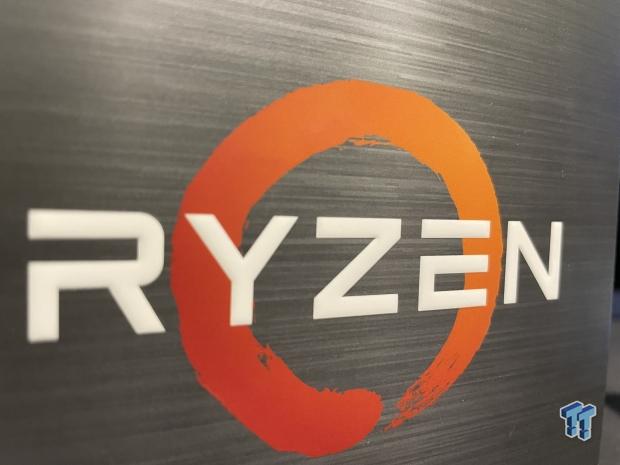
Ryzen 7, for the first two generations, were the flagship products. With Matisse, this changed with the introduction of Ryzen 9. Since then, the X700 and X800 products have filled the gap between the entry-level X600 series processor and the enthusiast X900 and X950. For many, this is the sweet spot offering top notch gaming performance with enough cores to handle simultaneous workloads like streaming or editing and encoding.
Ryzen 7 5800X is a 1x CCD 1x IOD part in the Zen 3 "Vermeer" lineup. It's a 105w part that offers 8 cores and 16 threads with SMT, a base clock at 3.8GHz, and a boost clock of 4.7GHz. 32MB of L3 cache and 24x PCIe 4.0 lanes accompany the design.
Pricing
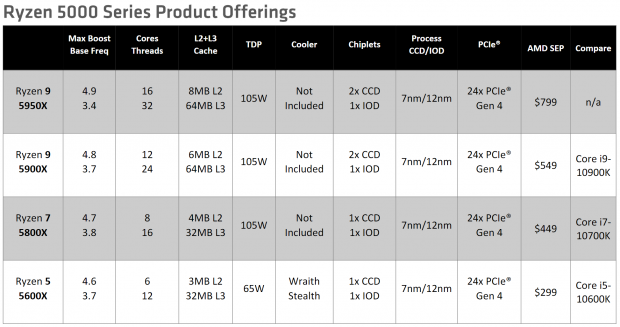
Above, we have the launch day product stack for Zen 3. This includes the Ryzen 5 5600X 6C12T part at the mainstream $299 price point and Ryzen 7 5800X 8C16T in the mid-range $449 slot. Ryzen 9 5900X takes the flagship position behind only the Ryzen 9 5950X in the enthusiast slot; $549 and $799, respectively.
You can read more on the AMD Zen 3 architecture in our Ryzen 9 5900X review here, since it won't be covered here.

Packaging and Test System
Ryzen 7 5800X
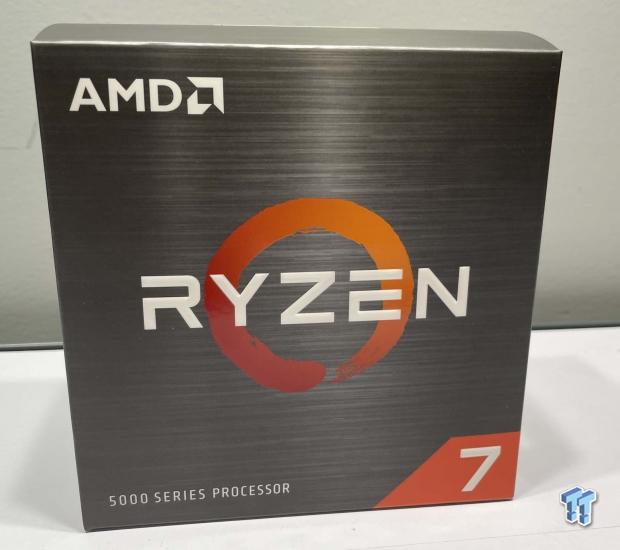
The Ryzen 7 5800X will wrap up our current coverage of Zen 3, although we will be taking the 5600X and this 5800X for a spin on a few new motherboards quite soon. That said, the packaging is no different from the 5800X, Ryzen logo centered with the 7 bottom right.
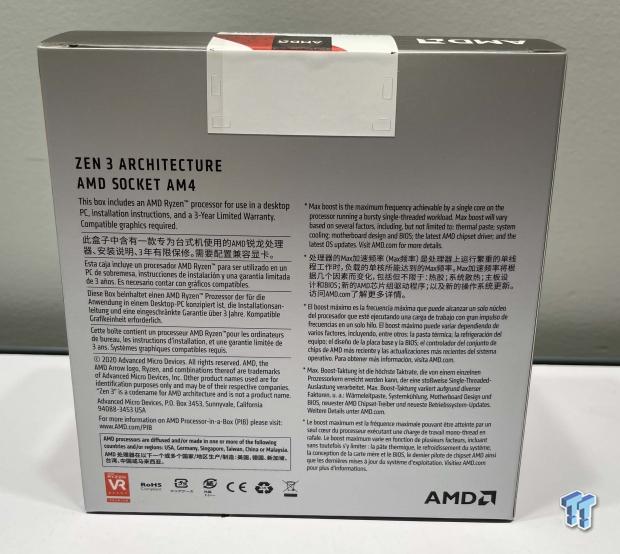
The back offers information about the processor in several languages.
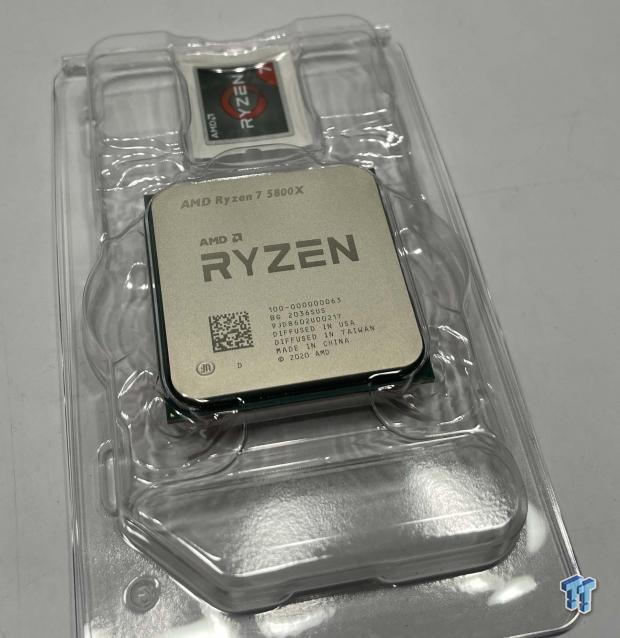
CPUs were packaged in a locked plastic retainer, sticker alongside for your chassis.
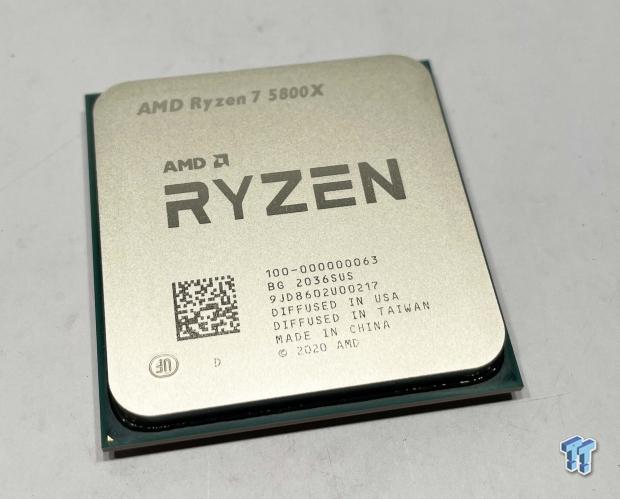
A closer look at the 5800X, the model number is etched across the top while down below we have the diffused in USA and Taiwan for each Fab respectively.
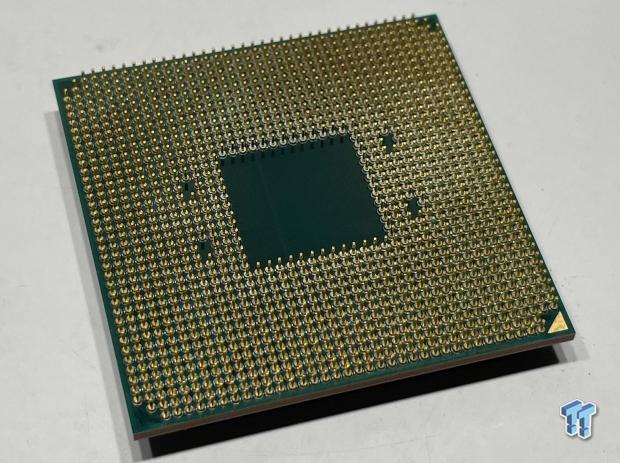
The bottom of the CPU offers the 1331 pin arrangement designed for the AM4 socket.
Test System
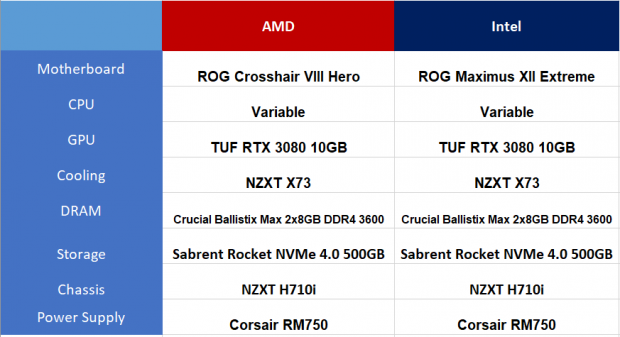
- Motherboard: ASUS ROG Crosshair VIII Hero Wi-Fi (buy from Amazon)
- GPU: ASUS TUF RTX 3080 10GB (buy from Amazon)
- RAM: Crucial Ballistix Max 2x8GB DDR4 3600 (buy from Amazon)
- Cooler: NZXT X73 (buy from Amazon)
- OS Storage: Sabrent Rocket NVMe 4.0 500GB (buy from Amazon)
- Power Supply: Corsair RM750 (buy from Amazon)
- OS: Microsoft Windows 10 (buy from Amazon)
WPrime, Cinebench, RealBench and AIDA64
WPrime
WPrime is a leading multi-threaded benchmark. In our setup, we will manually set the number of cores for the CPU under test.
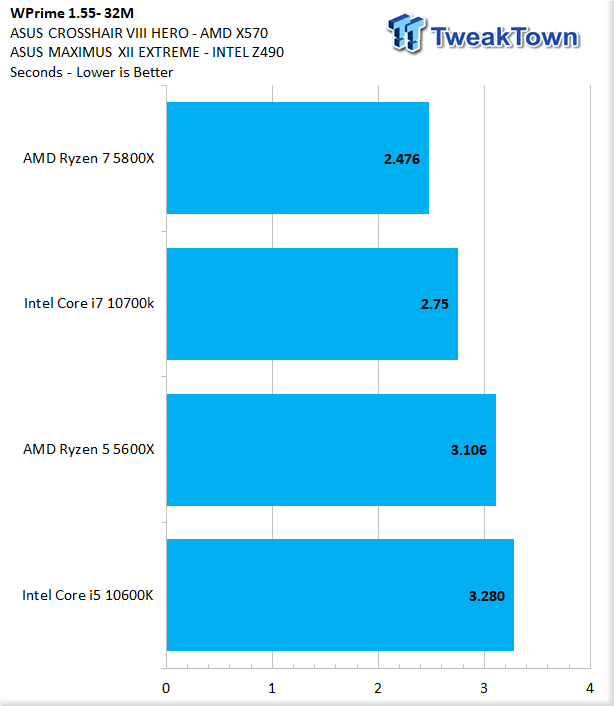
This review is going to be another focused on just the entry-level to mid-range market. The 5800X against the 10700K is our focus here. Starting our testing, the 5800X does quite well with 32m at 2.476 seconds.
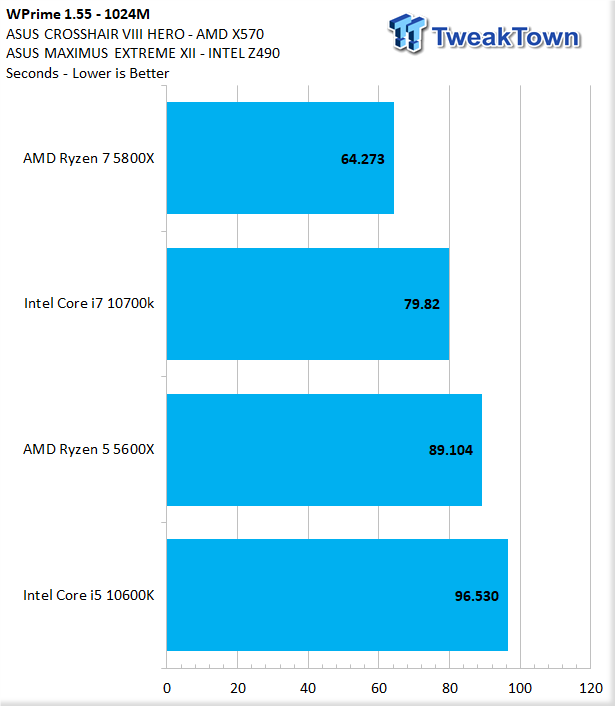
Moving over to 1024m, the 5800X bests the 10700k by 15 seconds with a time of 64.27.
Cinebench
Cinebench is a long-standing render benchmark that has been heavily relied upon by both Intel and AMD to showcase their newest platforms during unveils. The benchmark has two tests, a single-core workload that will utilize one thread or 1T. There is also a multi-threaded test which uses all threads or nT of a tested CPU
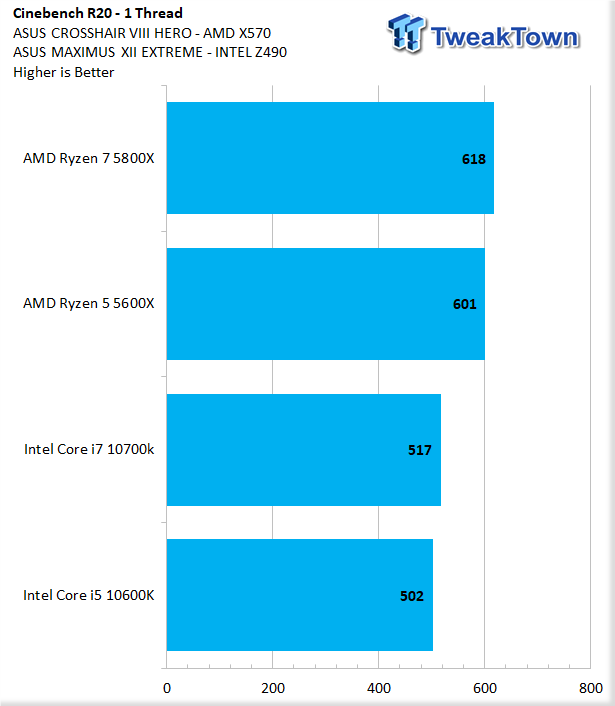
Single thread performance for the 5800X came in at 618, 100 over the 10700K.
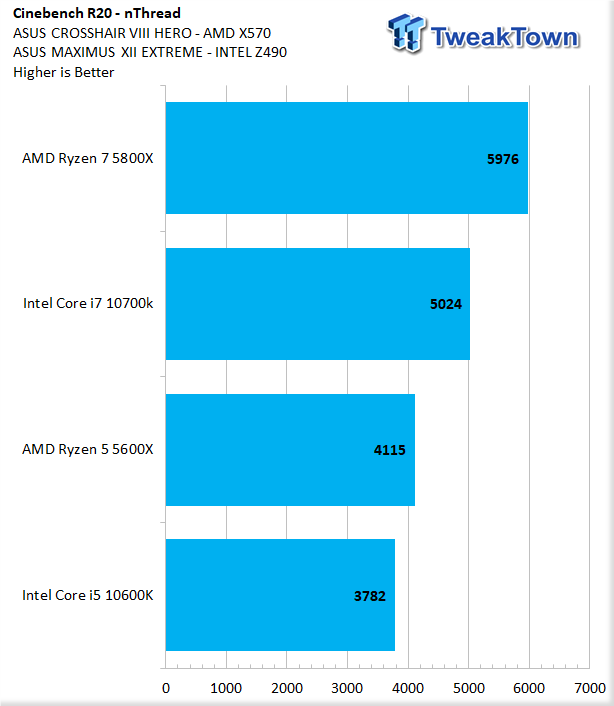
nT gave the 5800X a score of 5976.
RealBench
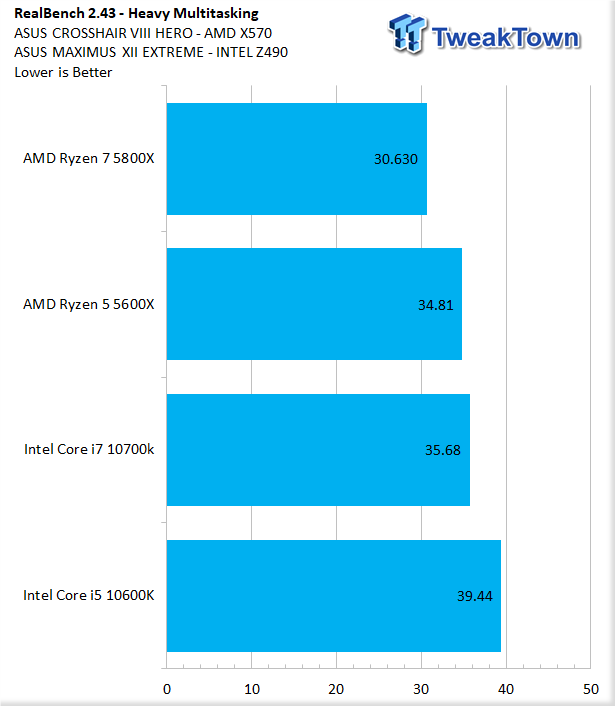
Heavy Multitasking runs both the image and encoding workloads alongside each other within Realbench. In this scenario, the 5800X is just over five seconds quicker than the 10700K.
AIDA64
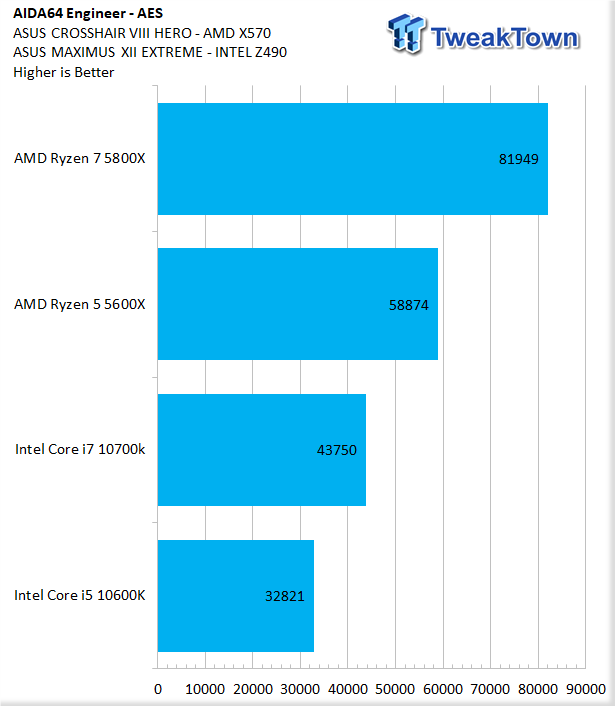
AES achieves a score of 81K for the 5800X, almost double the 10700K.
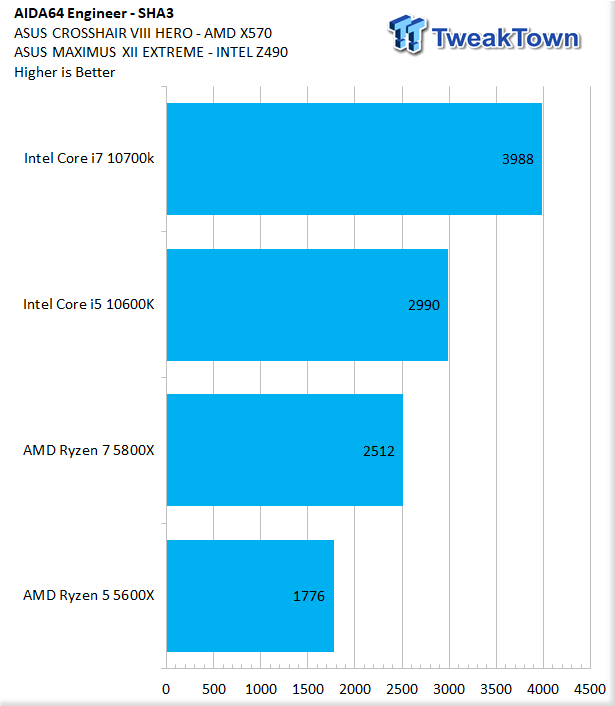
SHA3 still isn't quite as good as the 10700K, the 5800X lags by 1400 points here.

Adding in both FP32 and FP64, the 5800X holds a narrow advantage over the 10700K.
Unigine and UL Benchmarks
Unigine Superposition
Superposition from Unigine is a DX12 based benchmark. We test with the 720p LOW preset as this removes all but the most basic GPU loading, with all of the FPS coming from the CPU.
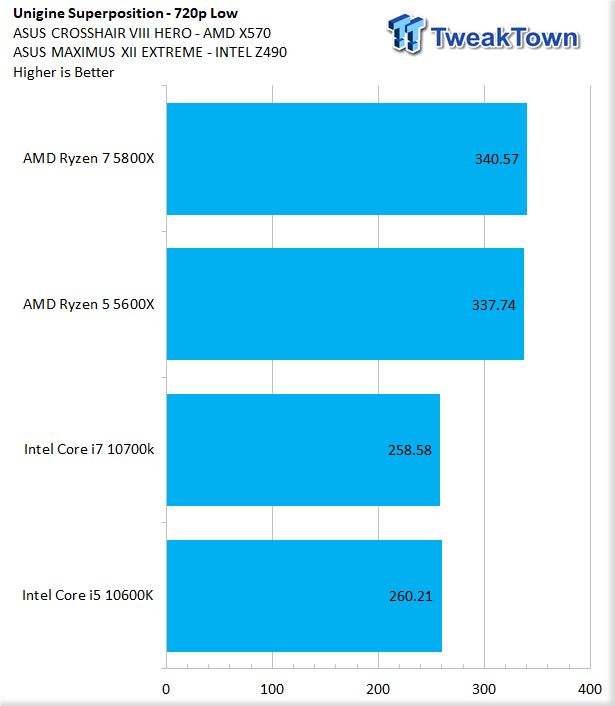
With Superposition, the 5800X breaks away from all others with 340 FPS.
PCMark 10
PCMark is a benchmark from UL and tests various workload types to represent typical workloads for a PC. Everything from video conferencing, image import, and editing, along with 3D rendering, are tested.

PCMark showed an overall score of 7794 for the 5800X.
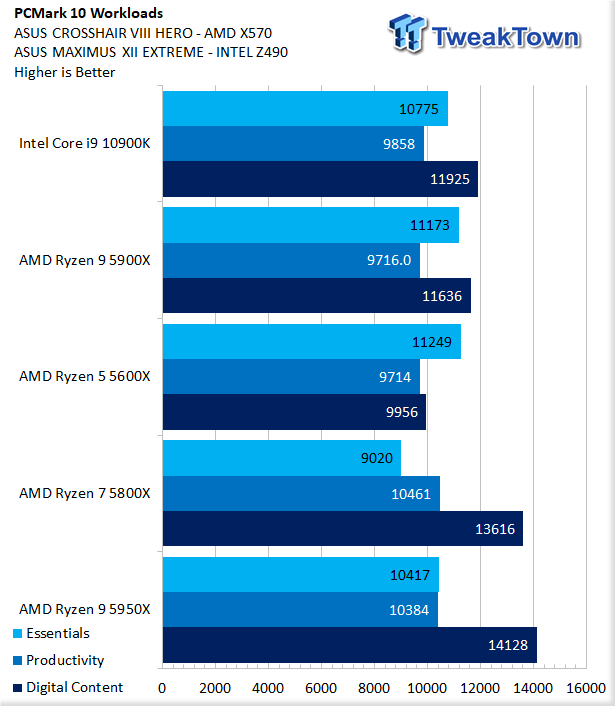
A closer look at our workloads shows a pretty solid advantage in digital content.
3DMark Firestrike
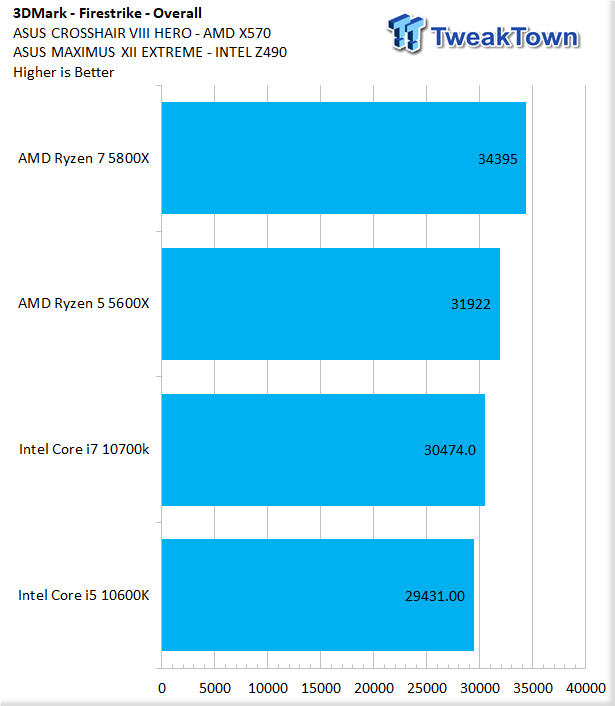
The 5800X does a rather amazing job with Firestrike, reaching an overall score of 34395, 4K higher than the 10700K.
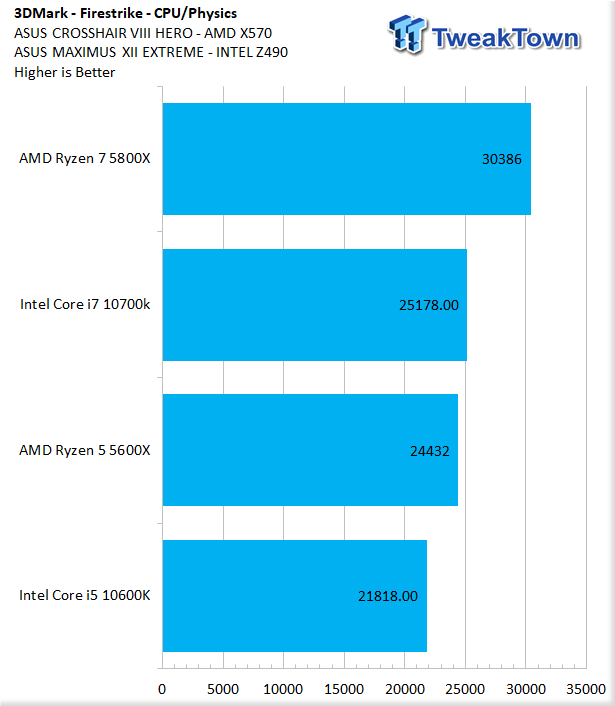
If we isolate CPU score only in Firestrike, the 5800X wins this with a 5K point advantage.
Gaming and Price v Performance
Gaming Performance
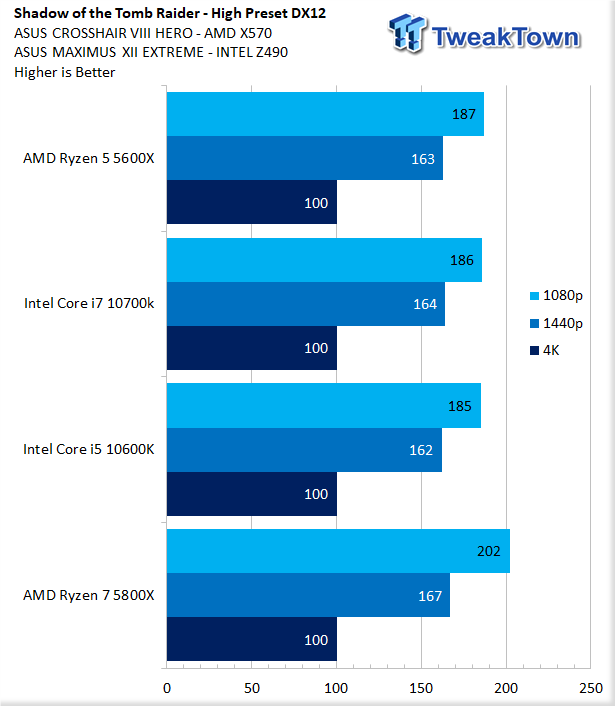
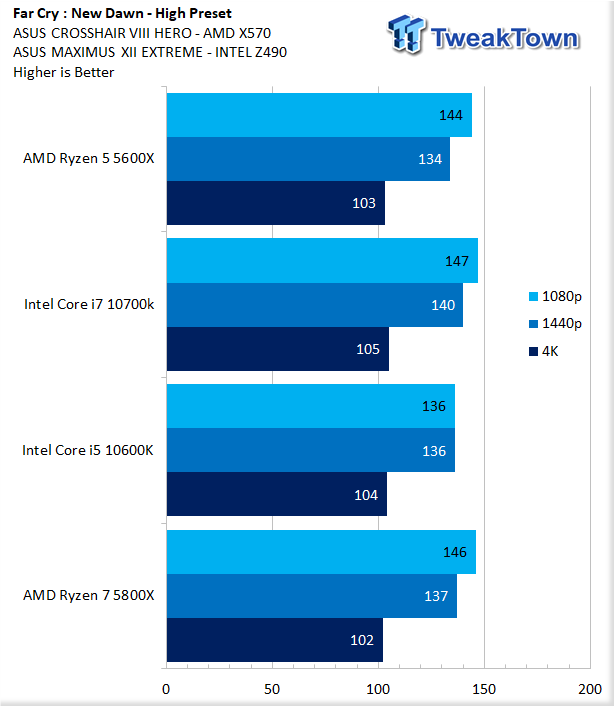
In our testing, games like Tomb Raider show no advantage in 4K, and 1440p is damn close too. 1080p swings to the 5800X with 202FPS.
Far Cry New Dawn is much tighter of a contest, with no clear winner at any resolution.
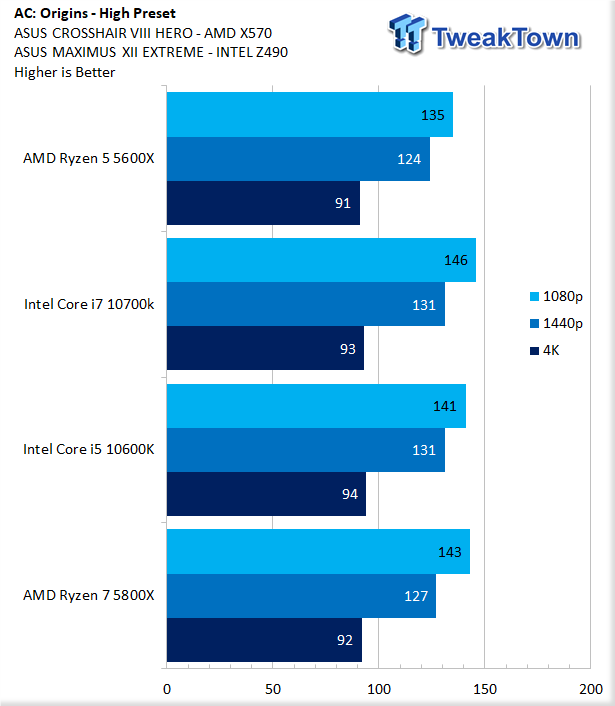
AC:Origins shows 92-94FPS for 4K testing, 1440p leans Intel, and 1080p has the 10700K at the top by 3 FPS.
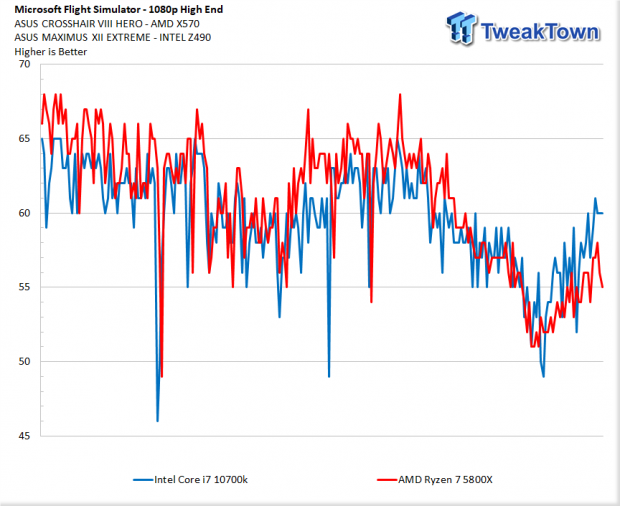
I decided to get away from Ubisoft games and move into a more recent title with Flight Simulator. I used FRAPS to log frame rates over a 4-minute flight from Portland Intl USA towards a local airport called Skyport. This benchmark was run at 1080p on the High-end setting with auto-pilot engaged from start to finish.
Throwing the 5800X through this scenario, we see it outperforms the 10700k by a few FPS throughout testing.
Price v Performance
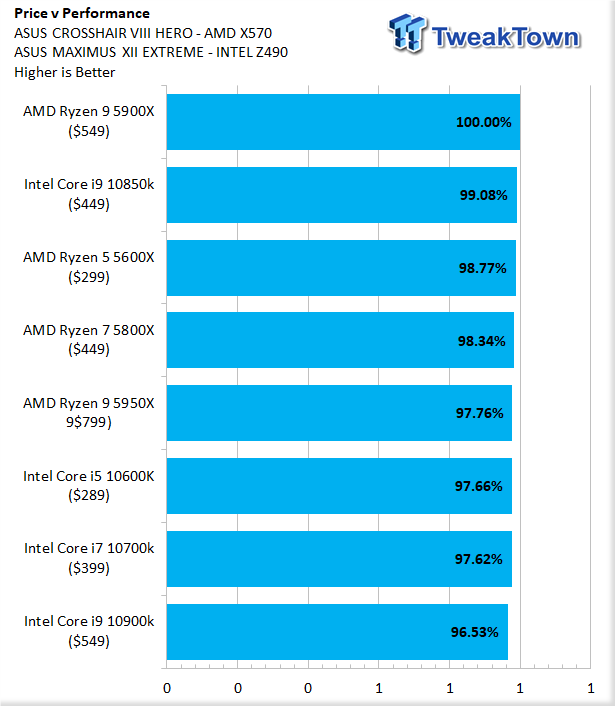
Taking all of the results we have received over the past few weeks testing Zen 3, we built a formula for calculating price v performance using the given MSRP.
We can see the 5800X lands quite a bit above the 10700K at 98.3% with this info.
Power, Thermals and Final Thoughts
Power Consumption
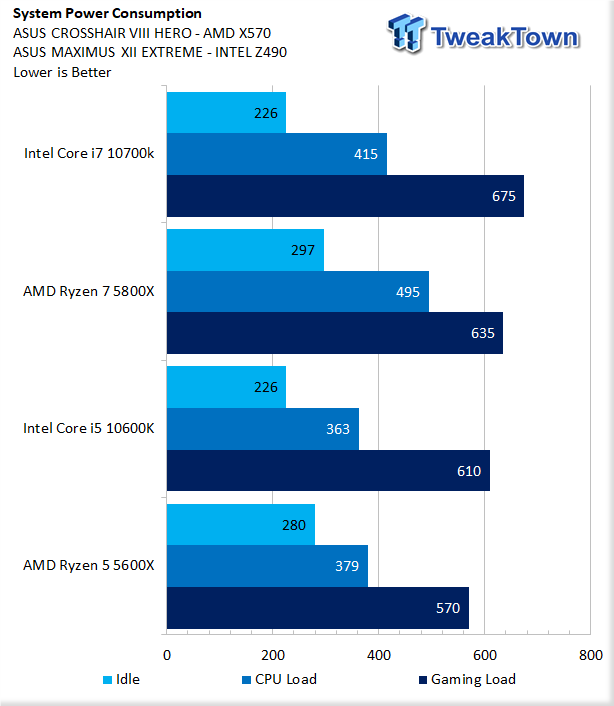
Power consumption for the 5800X is a bit higher than its Intel counterparts. That said, we have 297 watts at idle, 495 watts CPU load, and 635 watts during gaming.
Thermals
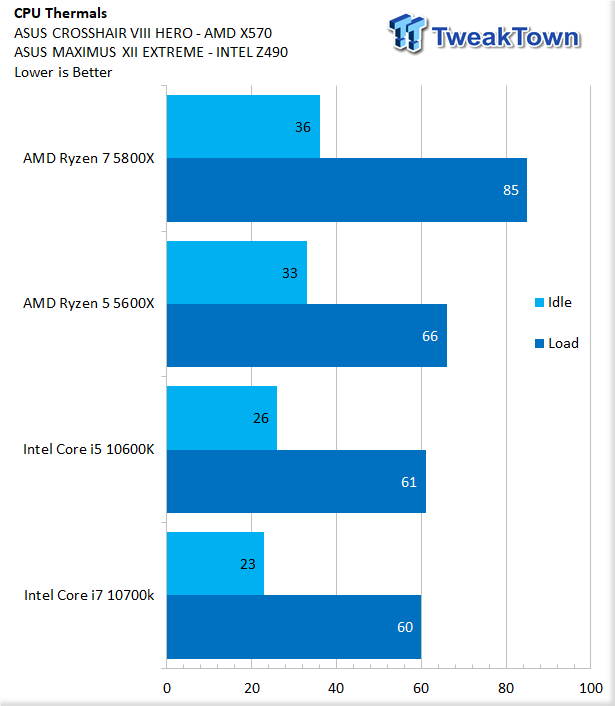
5800X reached the highest temperature of the CPUs tested. The 5600X is the only Zen 3 part that isn't so demanding on current-gen cooling solutions.
Final Thoughts
As mentioned earlier, AMD's Ryzen 7 5800X is the sweet spot for many gamers that want the extra core horsepower to stream or run a game server off the same PC simultaneously.
On that note, it was probably the best gaming processor we have tested over these last few weeks trading blows with the 5600X. The 5600X, with its 65W design, can keep its clocks higher longer because it doesn't have such a large heat load to contend with. The 5800X is half a 5950X but somehow produces a similar burden on our cooling solution.
Another thing to touch on with the 5800X is its placement in the market. AMD pushes it as a competitor to the Intel 10700K based on core count. When in reality, we must also look at its cost. At the time of writing, 5800X costs $449, and the 10700K costs $399. Intel more recently pushed 10850K to market to cover the transition to 10900K, with a price of $449. This pits the 10850K as a direct market competitor to the 5800X for users choosing a platform.
What We Like
IPC: Gen over Gen improvement is fantastic!
PCIe Gen4: Still the only platform to support Gen4 PCIe.
Long Live AM4: I've praised AMD in every review for sticking with AM4.
What Could Be Better
Heat: 5800X carries over the heat too but its well maintained with proper cooling.
Value: Price per core is at its peak with the 5800X, at $56 per core.
Note: We will cover 5800X overclocking in an upcoming motherboard soon.
Performance |
95% |
Quality |
95% |
Features |
95% |
Value |
90% |
Overall |
94% |
AMD's Ryzen 7 5800X delivers a fantastic CPU for gamers, streamers, and professionals!

Related Tags

